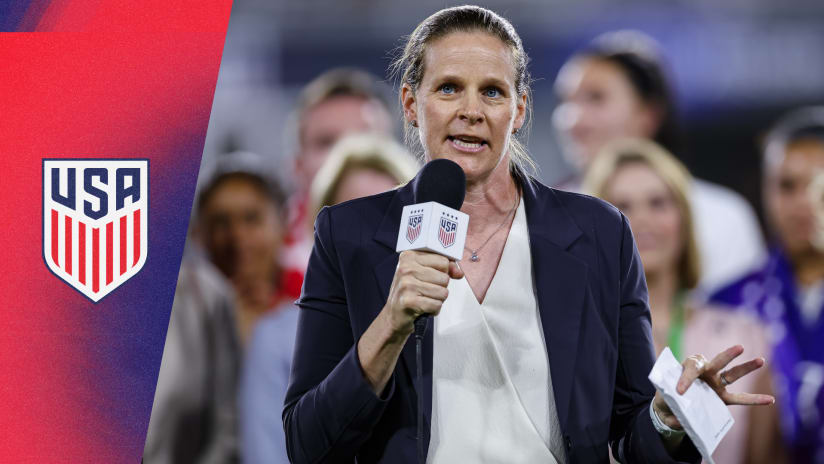US Soccer projects an operating deficit of $9.5 million for the 2024 fiscal year and is prepared to spend twice as much money as it makes on the US national teams during that time.
But there will be no limitations of finances or scope when it comes to the hiring of the next US men’s national team manager, according to federation CEO JT Batson.
“We had very clear support from our board around having it be a global market and understanding that anything is on the table with regards to who the right person is to lead our men's national team program,” Batson told reporters after the federation's annual general meeting in San Diego on Saturday.
“Obviously, you want to be smart with regards to how you spend money, but there's costs and there's also opportunities for revenue. So as we think about our men's national team program, we want to make sure we have the best person leading our men's national team going forward and it'll be a global market … we're not starting with any restrictions in that regard.
“With regards to what we budgeted for different types of things, even within a quarter or two or three or four, things change. And so what the market is for coaching talent will continue to evolve and we want to make sure that we have the best coach possible for our team.”
That was one of several tidbits shared by Batson and USSF president Cindy Parlow Cone, including significant changes in the duties assigned to the one slated to hire the next USMNT boss: the sporting director, a position currently vacant in the wake of Earnie Stewart’s departure for Eredivisie side PSV Eindhoven.
“We are actively interviewing,” Batson said of the hunt for Stewart’s successor. “Previously we had shared that our plan was to ensure we had a sporting director in place in time for the Women's World Cup this summer, which we're still on track for. We aren't in a position to go into details with regards to the number of people we've interviewed and the sort of full exact process. But we've been very pleased with the people who've raised their hand and the conversations we've had to date.”
Sporting director position restructured
Several candidates have been linked to the vacancy in recent weeks, including former USMNT star Oguchi Onyewu, Philadelphia Union sporting director Ernst Tanner, Sporting Kansas City manager and technical director Peter Vermes and Nashville SC GM Mike Jacobs, though those last three reportedly also removed themselves from consideration after preliminary talks.
Whoever is eventually selected between now and summer will likely have a more focused purview. USSF internal evaluations discovered Stewart’s responsibilities were so broad and extensive as to require them to be split among two people rather than just one, with the new post “a super strategic role for U.S. soccer and for soccer in this country,” according to Batson.
“The job was huge. And so what we're looking at now is kind of taking out some of the responsibilities that were under the sporting director before and having the sporting director really focused on our national teams,” said Parlow Cone, a US women's national team program icon during her own playing career. “We have 27 national teams, which is a huge job in and of itself, so [we’re] really focusing on those and our technical plan at the elite level and moving everything else that was under Earnie to a different position.
“Coaching education, referees, and then the youth and the adult amateur [areas],” she explained. “One person leading that is really directing that in our strategy, and the direction that we're moving with the larger soccer ecosystem, and the sporting director really focusing on our elite pathways and our national teams.”
USMNT players to have a voice
Mindful of the massive opportunity posed by a 2026 World Cup on home soil, the federation aims to be ambitious with its men’s national team hire. Widespread reporting has noted many of the world’s elite managers are compensated at much higher levels than previous USMNT coaches, however: Gregg Berhalter was paid $1.3 million annually while the $3.3 million paid to Jurgen Klinsmann in 2018 remains the highest-ever outlay on the position.
Parlow Cone also said current members of the USMNT will have a voice in the selection process for their next head coach.
“We'll definitely consult the players,” she said. “Obviously, we're not to that point yet, as we're focused on hiring the sporting director, but when we get to the point of hiring a head coach, just like we did on the women's side before we hired Vlatko [Andonovski], we'll do the same on the men’s side.”
The drastic financial shortfalls brought on by the COVID-19 pandemic have eased, and USSF board member Michael Karon said on Saturday that “we should get very close to break-even over the course of the next budget cycle and actually move from a deficit position to a surplus.” Batson framed continued fiscal growth as an urgent federation priority.
U.S. Soccer projects $172.7 million in total operating revenue in the next fiscal year, a marked rise from FY23’s $136 million, and in his speech to the national council, Batson pointed to growth in commercial partnerships via “a robust pipeline of some of the biggest brands in the world” and new records set for merchandise sales.
The national teams overall are slated to cost $92.7 million in FY24 while bringing in $46 million in revenue, though bumper income from USMNT and USWNT events – the latter will vie for a third consecutive World Cup championship in Australia/New Zealand this summer – could alter that outlook.














